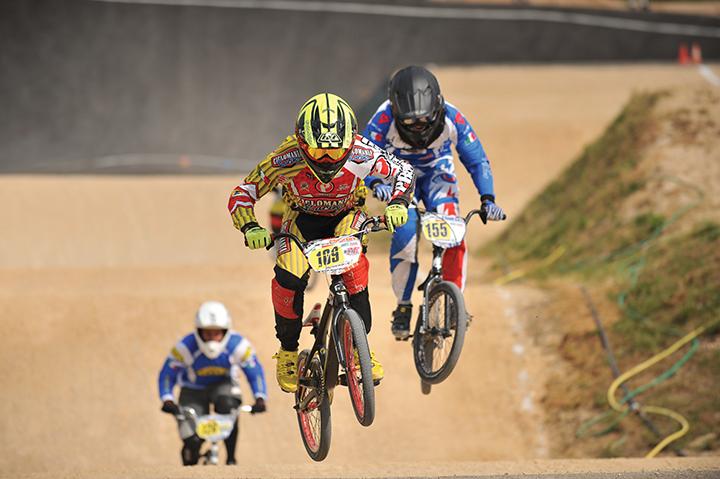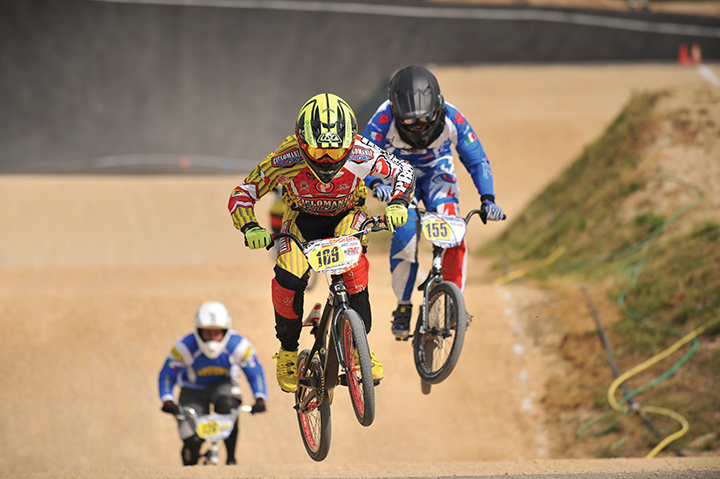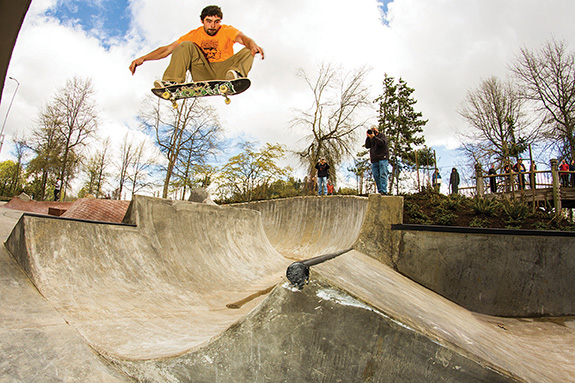
 Talk about good timing. On April 6, 2016, exactly one day after Tulsa voters approved the $15 million construction of a national headquarters for USA BMX and a National Track Stadium, the sport’s national governing body officially announced it would relocate its entire operation from Chandler, Arizona, to this northeastern Oklahoma community by the summer of 2019.
Talk about good timing. On April 6, 2016, exactly one day after Tulsa voters approved the $15 million construction of a national headquarters for USA BMX and a National Track Stadium, the sport’s national governing body officially announced it would relocate its entire operation from Chandler, Arizona, to this northeastern Oklahoma community by the summer of 2019.
The move’s economic impact is estimated at $10 million and has served to solidify Tulsa’s status as one of the premier BMX destinations in the country.
BMX roots run deep in the city, which in 2015 become the first in the United States to offer STEM programs that teach elementary school students how to build BMX bicycles using the STEM principles of science, technology, engineering and math.
Plus, for the past two decades, the River Spirit Expo Center has hosted the sport’s largest racing competition, the USA BMX Grand National Pro Series Finals. The indoor event happens every Thanksgiving weekend and brings in an average of 3,000 riders who, in 2016, represented 47 states and 21 countries. The number of spectators for the four-day event nearly topped 10,000.
“The Super Bowl of BMX is in Tulsa,” proclaims Vince Trinidad, executive director of the Tulsa Sports Commission, which was instrumental in securing approval of construction funding for the USA BMX project. “There is an entire generation of riders who don’t know anything other than going to Tulsa for Thanksgiving.”
And when A Gathering Place for Tulsa — a new 25,000-square-foot skatepark — opens in late 2017 as one of the largest privately funded facilities of its kind, Trinidad says freestyle BMX events likely will be incorporated into its programming, too.
BMX Facilities Gain Traction
While Tulsa can be considered an epicenter, it certainly is not the only city on a roll when it comes to offering memorable BMX experiences. Communities in which the sport plays an active role in the local culture are among the most successful in attracting large-scale, high-profile events, and many BMX tracks that host races also boast long and colorful histories that have evolved with the sport.
“BMX has been around since the 1970s,” says Nick Adams, track operator for Grand Valley BMX in Grand Junction, Colorado, which opened in the 1980s and is now headquartered at the Mesa County Fairgrounds. “The sport is a great opportunity for people of all ages to compete. Through the years, BMX racing bikes have evolved, and so have the tracks. With BMX racing becoming an Olympic sport in 2008, the popularity of the sport increased, and the advent of college cycling programs adding BMX has also helped garner attention.”
Indeed, the website for Grand Valley BMX claims the facility is “open to boys and girls (ages 2-92) who can ride a bike.”
Grand Valley BMX attracts a lot more riders of all ages these days, thanks to a major renovation in 2015 that made the venue — surrounded by beautiful mountains — a focal point of the fairgrounds. The updated facility now features paved walkways for spectators, covered bleachers, a shade structure for riders and one of only six Olympic-caliber starting hills in the United States.
The facility hosts more than 100 events annually, including the USA BMX Mile High Nationals and North American Supercross Series. That marquee event generated an economic impact of almost $1 million in 2015, its first year at Grand Valley BMX, Adams says, and the high-stakes competition will return in 2017.
Spokes BMX Race Track in Springfield, Missouri, also boasts a long history and has become a go-to destination. In 2015, the outdoor facility hosted a USA BMX Gold Cup Regional Championship, which attracted 450 riders from more than 30 states plus other countries. This August, the facility will welcome the Mid-America Nationals for the first time, and Lance Kettering, sports sales manager for the Greater Springfield Area Sports Commission, expects more than 600 riders.
Spokes BMX is part of the Ewing Sports Complex, and although it is owned by the city, volunteers keep it operating.
“Not to toot our horn, but the sports commission approached the track and said we think there is a chance to get some major events here,” Kettering says. “Our performance at the 2017 Mid-America Nationals will go a long way in showing we can host national events of that caliber.”
A third major facility on the USA BMX circuit is the Deschutes County Fairgrounds and Expo Center, located in Redmond, Oregon, and home of the Great Northwest Nationals, which pulls riders from 17 states, plus countries as far away as New Zealand. This year’s event, slated for April, marks the first time the Great Northwest Nationals will be considered a world qualifier, meaning the stakes for riders will be higher than ever.
Fairground officials are ready for the increased pressure. The Bank of the Cascades Center at the fairgrounds offers 4,000 permanent seats and stores 3,000 cubic yards of dirt on site. “You can almost reach out and touch the riders,” says Dan Despotopulos, director of the fairgrounds and expo center. “There’s not a bad seat. Our facility is perfect for this type of event in the way it’s designed. A 22-foot-wide concourse is located at the top of the seating and provides good views and areas for team meetings and bike repair.”
Despotopulos says he hopes to secure another annual USA BMX event that would take place in the fall.
 Skate of the Nation
Skate of the Nation
Like BMX, skateboarding may have begun as a counterculture movement that eventually became more mainstream than some longtime participants would prefer. But one thing that has not changed is the sense of community the sport fosters.
The stories behind some skateparks are just as intriguing as the facilities themselves. Consider Tinnell Memorial Sports Park, Arizona’s largest skatepark at 40,000 square feet and located along the lakefront in Lake Havasu City.
Operated by the city, the park was built in memory of Patrick Tinnell, a local BMX enthusiast and U.S. Army soldier who died in 2006 while in Iraq, as well as Colin Sasseen, a 14-year-old Lake Havasu City native who lost his life in 2007 while skateboarding in the driveway of his family home when he fell into the street in front of an oncoming car.
“Both Patrick’s and Colin’s stories are posted at the park, and I know that many of those that served with Patrick have visited from different areas of the country,” says Rachelle Marchbanks, co-founder of the park, which was funded in part by donations from the local community. “This park stands as a reminder of those that put their lives on the line so we can live the American dream.”
The street course design is inspired by the “skate plaza-style” course used by professional skateboarders at the 2013 X Games at Foz Do Iguacu, Brazil. The upper deck of the park has a backyard bowl, a competition flow course and a wall ride around a palm tree. Shade structures provide spectators and skaters shelter from the Arizona sun.
Two elements of the park were designed and incorporated to honor Tinnell and Sasseen: A custom cradle in the shape of Tinnell’s Army helmet makes the facility immediately identifiable, and a large stained-concrete “C” at the bottom of a 14-stair set pays tribute to Sasseen.
Up until now, the park has hosted a handful of high-profile events every year, but Marchbanks says “there is talk of some big events” for 2017.
Big things are happening at the Skatepark of Tampa, too — or, as it’s commonly called, SPoT. From all-ages competitions to high-level amateur (Tampa Am) and pro (Tampa Pro) events, something always seems to be going on at this privately owned 25-year-old park. Additionally, SPoT staff members host six skating contests at sites throughout the world, with the winners receiving automatic bids to the Tampa Am. SPoT also runs a retail skate shop that helps raise the facility’s profile.
“Retail helps in the day-to-day [operations],” says Jeni Armstrong, who oversees skatepark operations. “The events draw people to the park to help the retail, so they go hand in hand. Our online store really carries the company more than the brick-and-mortar store.”
As with most skateparks, the local skating community plays an integral role in helping the facility maintain its reputation. “Everyone is always welcome but also protected,” Armstrong says. “They watch out for each other and push each other to be better — not just as a skater but as a person. For example, we had had a pile of local skaters show up to Thanksgiving dinner, because they didn’t have any other place to go. It’s not just a skatepark or retail shop, it’s a safe space.”
That “safe space” component of skateparks is what has helped make Long Beach, California, what Mike Donelon calls “one of the most skateboard-friendly cities in the United States.”
Donelon is a former city council member who since 2000 has helped establish small 3,000-square-foot skateparks in neighborhoods all over Long Beach to lower crime rates and build self-esteem in at-risk kids. He founded the Action Sports Kids Foundation to raise money to build these parks, and a ninth skatepark is expected to open in early 2017.
Bixby Park, among the most iconic in the United States with its simple design featuring no ramps, stairs or rails, attracts skaters from all over the world, and four “Am/Jam” competitions named after local skaters who died — two from gunfire and two from skateboarding accidents on the street — draw hundreds of kids; that number is increasing.
“As we’ve grown, our reputation has grown, and there are more kids coming to our events,” Donelon says, adding that the Long Beach Convention & Visitors Bureau has been instrumental in helping the parks secure more events and put Long Beach on the map as a national action sports city.
Local skaters also participate in volunteer cleanup efforts, demos and lessons — activities that ultimately improve the quality of life in Long Beach. “We showed the city that these are good kids who want to be involved in their community and make a difference,” Donelon adds.
The Best of Both Worlds
While many BMX destinations also have some skateboarding opportunities and vice-versa, few offer the same caliber of opportunities in both sports — but Eugene, Oregon, multi-tasks handily.
“Skateboarding and BMX are a huge cultural piece of what we have here,” says Joey Jewell, director of sports sales and development for the Eugene, Cascades & Coast Sports Commission. “The counterculture is synonymous with the Pacific Northwest, and those sports fall into that category.”
Eugene has made headlines in both activities in recent years, and shows no signs of slowing down.
Emerald Valley BMX welcomed the USA BMX Gold Cup Championship Final Northwest in September, a national BMX race that brought in riders from surrounding states and Canada. It marked the largest-scale event Emerald Valley BMX has hosted, Jewell says. The track has undergone surface improvements over the past two years and is looking for more high-profile events.
In 2014, after 10 years of discussions and planning, Eugene opened the 23,000-square-foot WJ Skatepark — the largest partially covered and lighted facility of its kind in the United States. Located in Washington Jefferson Park, the skatepark also permits BMX bikes and scooters, and it attracted both the Extreme Amateur Games and Collegiate Skate Tour in 2016.
“This culture is not new here, but it’s not done growing, either,” Jewell says. “There are always opportunities to grow.”

